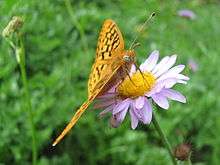Speyeria zerene
| Zerene fritillary | |
|---|---|
| | |
 | |
| Speyeria zerene hippolyta | |
| Scientific classification | |
| Kingdom: | Animalia |
| Phylum: | Arthropoda |
| Class: | Insecta |
| Order: | Lepidoptera |
| Family: | Nymphalidae |
| Tribe: | Heliconiini |
| Genus: | Speyeria |
| Species: | S. zerene |
| Binomial name | |
| Speyeria zerene Swainson, 1827 | |
Speyeria zerene, the zerene fritillary, is a species of butterfly found in the western portions of the United States and Canada.
Description
Speyeria zerene is a medium-sized butterfly whose length ranges from 25–28 mm, and the wingspan is about 55 mm. The body of the butterfly is black with orange-brown on the upper side of the wings. Also on the underside are black veins with black spots. The undersides of the wings have silver metallic spots. The wings and the body are both covered in fine hairs.
Range
The native range spread from Washington state to California. They are now found in Oregon and California. As of 2013, they were found in numbers in Alpine County, California, at the 9,000 foot level in the Sierra Nevada range. The best habitats for the butterflies are coastal salt spray meadows, montane meadows, and stabilized dunes. The grasslands provide larval host plants which are a very important component of their habitat.
Subspecies
About 15 subspecies are accepted.[1]
- Speyeria zerene behrensii (W. H. Edwards, 1869) – Behren's silverspot
- Speyeria zerene bremnerii (W. H. Edwards, 1872)
- Speyeria zerene gloriosa Moeck, 1957
- Speyeria zerene gunderi (J. A. Comstock, 1925)
- Speyeria zerene hippolyta (W. H. Edwards, 1879) – Oregon silverspot
- Speyeria zerene malcolmi (J. A. Comstock, 1920)
- Speyeria zerene monticola (Behr, 1863)
- Speyeria zerene myrtleae dos Passos and Grey, 1945 – Myrtle's silverspot
- Speyeria zerene picta (McDunnough, 1924)
- Speyeria zerene platina (Skinner, 1897)
- Speyeria zerene puntareyes J. Emmel and T. Emmel in T. Emmel, 1998
- Speyeria zerene sinope dos Passos and Grey, 1945
- Speyeria zerene sitka Hammond, Harry and McCorkle, 2001
- Speyeria zerene sonomensis J. Emmel, T. Emmel and Mattoon in T. Emmel, 1998
- Speyeria zerene zerene (Boisduval, 1852)
Conservation
In 1999, the U.S. Fish & Wildlife Service initiated a recovery plan for Speyeria zerene. The recovery program helped establish breeding programs in several zoos and colleges that provide captive rearing forSpeyeria zerene. In late summer, female butterflies are captured after they have mated with a male and then transferred to a facility where they are induced to lay eggs. After the eggs hatch, the larvae are stored in a refrigerator over winter in order to replicate the conditions of the season. After the winter dormancy, the larvae are fed and cared for until they pupate or are large enough to be returned to the wild.

Other programs that are being implemented to help the wild population include the regular mowing of meadows by private home owners, and especially habitat restoration for properties owned by the U.S. Fish and Wildlife Service. One of the most essential components of the Speyeria zerene habitat is the blue violet, or Viola adunca; it is used for the food and shelter of the early stages of a larva's life. However, the blue violet is also threatened by invasive species and the overgrowth of shrubs and trees in meadows. The facilities that have established breeding programs for the butterflies have also set up nurseries for the blue violets. These nurseries are mainly used to provide food for the larvae reared in these facilities, but some violets are also transported and planted in restoration sites.
Life cycle
The life cycle of Speyeria zerene begin when the pink-tan-colored eggs hatch. Females lay these eggs on the dried stems and debris of the blue violet (Viola adunca). The larvae, which have spikes on their backs and are dark in color, emerge in the spring. The larvae grow in six stages of development (instars) and feed on the violet until it is time for the larvae to pupate, which they do on the violet. The pupae will remain there for approximately two weeks, until it emerges as a butterfly. The butterfly has a life expectancy of about three weeks. During this time the butterflies mate and feed solely on nectar. Females then lay eggs, and the life cycle starts again.
Diet
The diet of Speyeria zerene varies throughout its life history. When the larva emerges in the spring the diet consists solely on the leaves of the blue violet (Viola adunca). When the adult emerges from its chrysalis it will feed solely on nectar of flowers. It feeds on a variety of plants including ones from the Asteraceae family, its main source of nutrition, but other families of plants that the butterfly may feed on include thistles, asters, yarrow, and pearly everlasting.
References and external links
| Wikimedia Commons has media related to Speyeria zerene. |
- ↑ "Speyeria zerene". Integrated Taxonomic Information System. Retrieved 2013-08-18.
- Oregon Silverspot butterfly, Fish and Wildlife Service
- The Washington State department of fish and wildlife species of concern
- Silverspot Butterfly Fact Sheet, Woodland Park Zoo, Seattle, WA
- Silverspot Butterfly, Fish and Wildlife Service
- Speyeria zerene, University of Alberta, Entomology Collection
- Butterflies and moths of North America species detail page
